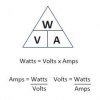Im dumb. I just realized that if I split the other loads (lighs, fans,...) between the two circuits, I can put about 750 watts and a DeHu on one circuit and the other 750 watts and the AC on the other circuit. I think the breaker (and wires) would like it better if I was pulling 750watts and then had ONE compressor kick on. Compared to pulling 50-100watts (fans only) and then having two compressors kick on at the same time.
I just discovered time vs current trip characteristic curves for breakers. The one I looked at had me believing I could run 75 amps through a 15 amp breaker for about 10 seconds before it trips. 135 amps might trip after 1 second. 150 amps might cause a delay, then trip. 300 amps might trip right away. Not sure if this is even reasonable, but seems to be - at least on an order of magnitude. I'm still researching starting current, but it sent me down a rabbit hole of hvac stuff. kVA/HP, NEC code letters, FLA, RLA, LRA, MOC, MCC, NUGZ,....


